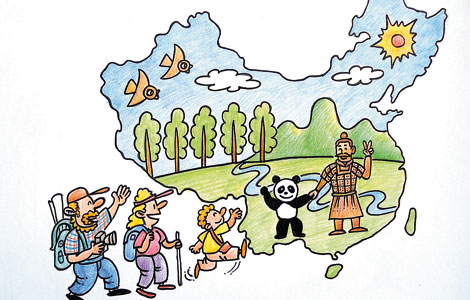Panda revelation
Updated: 2014-01-21 11:22
(China Daily)
|
||||||||
 |
|
Photo Provided to China Daily |
 |
 |
Today, pandas survive solely along the eastern edge of the Tibetan Plateau in six mountain ranges within Sichuan, Shaanxi and Gansu provinces, their habitat totaling about 23,000 square kilometers.
"The general consensus is that such rapid contraction must be ascribed to human population growth and land use rather than climate change," Zhang says.
With most valleys inhabited by humans, many pandas are isolated in narrow belts of bamboo no more than 1,000 to 1,200 meters in width.
"Therefore, their actual geographical range is much smaller than generally depicted on maps. Although the panda's total range encompasses 23,000 sq km, probably less than 20 percent represents their actual habitat," Zhang says.
Zhang and Bexell began working together in 1999, when Zhang joined the staff of the base as deputy director and Bexell was conducting giant panda behavioral research at the base for the United States' Zoo Atlanta.
Moved by the panda's plight, Bexell soon signed on to help the base develop the largest zoological education department in China. Shortly after, Zhang became the base director.
They had an immediate mutual respect for and interest in each other's work. They understood how crucial their respective areas of expertise were for the protection of giant pandas and their habitat.
Zhang specializes in veterinary medicine and genetics, and Bexell's areas of expertise are in animal behavior, conservation and humane education, the human-animal bond and international biodiversity conservation.
"Many species are in desperate need of help. So why focus on giant pandas? A major reason is their universal appeal and recognition. If we cannot rally humanity for a creature as universally appealing as the giant panda, what hope is there for the future of our planet as we know it today?" says Zhang.
Current rates of species extinction are greater than anything experienced on Earth since the cataclysmic natural event that caused the eradication of the dinosaurs 65 million years ago. Scientists estimate over half of the currently existing species may become extinct by 2100.
"It is urgent that humans come to understand that it is biodiversity in all its enormity and complexity that allows for our existence. It is biodiversity that provides and cleans our air and water, gives us food, protects us from diseases, buffers our storms and provides us with beauty and places of solitude. The biodiversity crisis we face today is partially the rationale for the production of the book," Bexell says.
"Scientists now believe biodiversity loss may pose the greatest threat to human survival and this issue requires our urgent attention," she says.

 Gorgeous Liu Tao poses for COSMO magazine
Gorgeous Liu Tao poses for COSMO magazine
 Post-baby Duchess
Post-baby Duchess
 Victoria Beckham S/S 2014 presented during NYFW
Victoria Beckham S/S 2014 presented during NYFW
 'Despicable' minions upset Depp's 'Lone Ranger' at box office
'Despicable' minions upset Depp's 'Lone Ranger' at box office
 'Taken 2' grabs movie box office crown
'Taken 2' grabs movie box office crown
 Rihanna's 'Diamonds' tops UK pop chart
Rihanna's 'Diamonds' tops UK pop chart
 Fans get look at vintage Rolling Stones
Fans get look at vintage Rolling Stones
 Celebrities attend Power of Women event
Celebrities attend Power of Women event
Most Viewed
Editor's Picks

|

|

|

|

|

|
Today's Top News
Memorial hall reflects on Japan's aggression
Missionary wants US to get him home
Tech park visits Bay Area
US may be losing in globalization
Students develop apps for campus life
Three dead in China food poisoning
Beijing blood donations drop
US commemorates Martin Luther King Jr.
US Weekly

|

|







